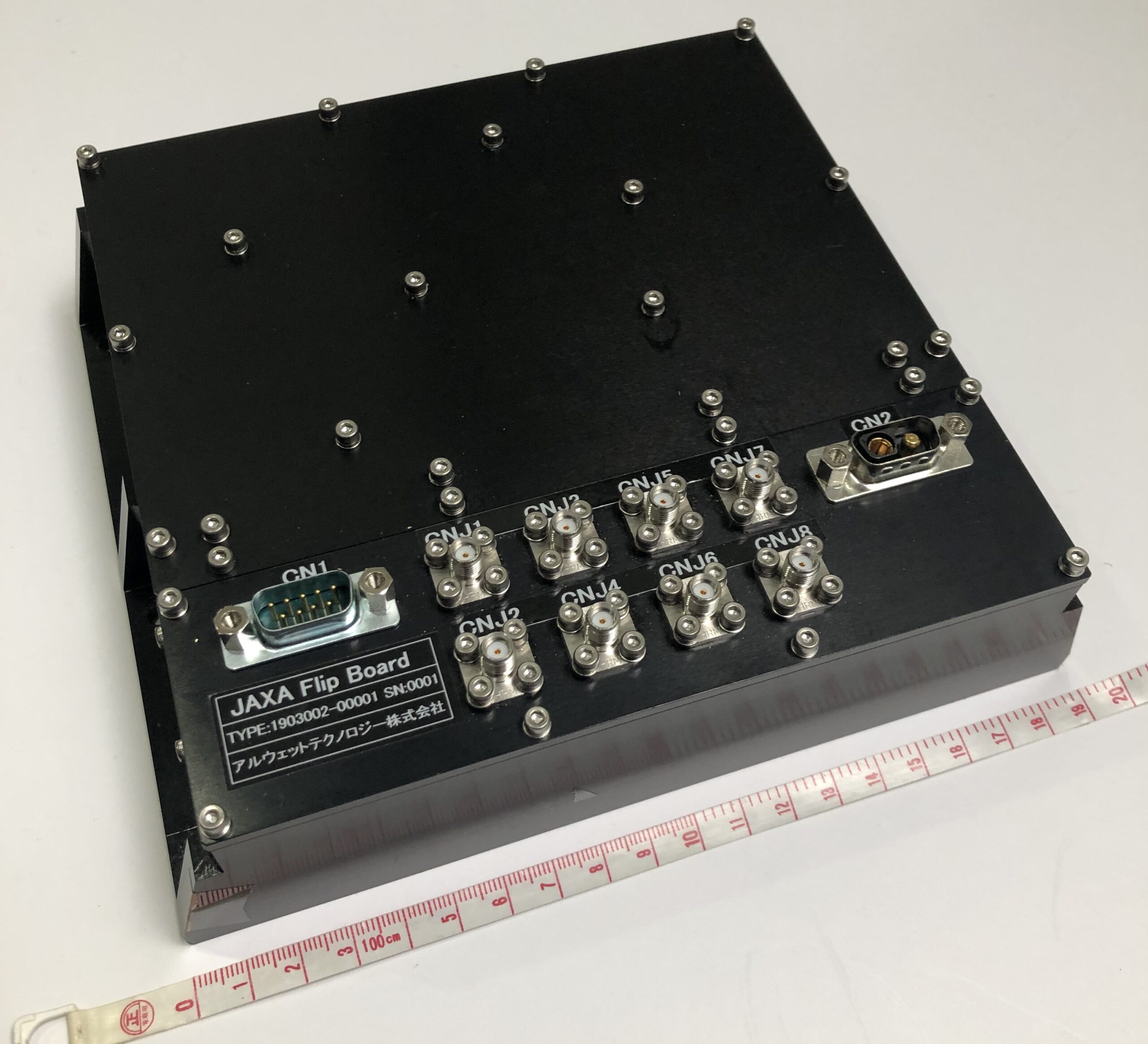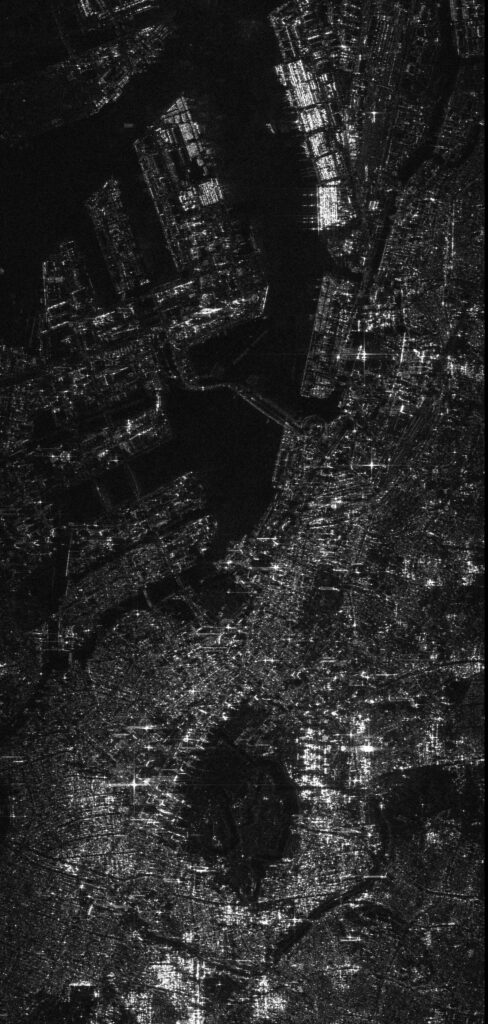合成開口レーダ(SAR)データの軌道上画像化に成功 / JAXA and iQPS achieve in-orbit imaging of synthetic aperture radar (SAR) data (English follows Japanese)

宇宙航空研究開発機構(以下、JAXA)と株式会社QPS研究所(以下、QPS研究所)はQPS-SAR 6号機「アマテル-Ⅲ」に搭載した、FPGA (Field Programmable Gate Array) を用いた「軌道上画像化装置」(以下、本装置)において、合成開口レーダ(SAR)(注1)データの軌道上での画像化に成功いたしました。
本装置は、従来は地上の計算機で行っていたデータ処理を、高速処理が可能なFPGAに適したアルゴリズムに書き換えてファームウェア化することにより衛星搭載用の装置として実現したものです。(注2)(図1)
JAXAとQPS研究所は、本装置を2023年6月13日に打ち上げられた「アマテル-Ⅲ」に搭載し、軌道上での技術実証に係る共同研究を行っています。
このたび、「アマテル-Ⅲ」の軌道投入後の初期チェックの一環として、あらかじめ衛星内に格納していたSARデータ(注3)に対し、本装置を用いて軌道上で画像化処理を実行した結果、高速(約23秒)での画像化に成功しました。(図2) さらに圧縮処理することで、地上への送信データ量を生データ送信時の1/1000以下(0.0845%)に圧縮することができ、地上でのSAR画像入手までの時間を大幅に短縮することができました。
本技術実証により、ユーザーがリクエストしてからSAR画像提供までの即応性がより高まることが見込まれ、QPS研究所が目指す36機の小型SAR衛星コンステレーション(注4)による準リアルタイム観測データ提供の実現に向けてさらに前進し、新たな価値の創出および社会課題解決の可能性、そして新しいビジネス展開が期待できます。
今後、JAXAとQPS研究所は、共同で軌道上実証結果の詳細解析を進めるとともに、「アマテル-Ⅲ」で取得したSARデータの軌道上画像化処理を継続して実施いたします。
(注1)
SAR (合成開口レーダ):電波を使用して地表の画像を得るレーダ。雲や噴煙を透過し、昼夜を問わず観測することができる点が特長です。
(注2)
プレスリリース「合成開口レーダ(SAR)データを軌道上で画像化する装置の共同開発成果について」(JAXA/アルウェットテクノロジー株式会社)
https://www.jaxa.jp/press/2020/02/20200226-1_j.html
(注3)
当データはQPS-SAR2号機「イザナミ」によって取得したもの
(注4)
複数の人工衛星によって、高頻度な地球観測を可能とするシステム。(コンステレーションは「星座」の意。)
(図1)SARデータの軌道上画像化装置 ©JAXA/アルウェットテクノロジー株式会社

(図2)羽田空港付近 ©JAXA/QPS研究所

JAXA (Japan Aerospace Exploration Agency) and Institute for Q-shu Pioneers of Space, Inc. (iQPS) successfully achieved in-orbit imaging of Synthetic Aperture Radar (SAR) (Note 1) data using FLIP(Fast L1 Processor), the onboard SAR imaging processor equipped on the QPS-SAR-6, “AMATERU-III.” FLIP has been successfully applied (Note 2) (Figure 1) by adapting algorithms suitable for high-speed processing on field programmable gate arrays (FPGAs).
JAXA and iQPS conducted a joint research for the in-orbit technology demonstration of FLIP, and launched it on June 13, 2023 aboard the AMATERU-III. As part of the initial checks after the satellite went into orbit, pre-stored SAR data (Note 3) was processed in-orbit using FLIP and was confirmed to result in successful high-speed (approximately 23 seconds) imaging (Figure 2). Furthermore, by compressing the raw data, the amount of data transmission was reduced to less than 1/1000 (0.0845%), significantly cutting the time required to obtain SAR images on the ground.
This technology is expected to increase the speed at which users will be able to receive SAR images on demand, further advancing towards the realization of near-real-time observation data through a constellation of 36 small SAR satellites pursued by iQPS. This progress holds the potential for creating new value, addressing societal challenges, and fostering new business opportunities.
(Note 1)
SAR (Synthetic Aperture Radar): A radar system that uses radio waves to obtain images of the Earth’s surface. Its ability to penetrate through clouds and smoke, and to observe day and night, are some key features.
(Note 2)
Press Release: ” Japan Aerospace Exploration Agency (JAXA) and Alouette Technology Develop Onboard Image Processor for Synthetic Aperture Radar (SAR) Data” (Japan Aerospace Exploration Agency / Alouette Technology Inc.)
https://global.jaxa.jp/press/2020/02/20200226-1_e.html
(Note 3)
The original SAR data was acquired by the QPS-SAR-2, “IZANAMI.”
